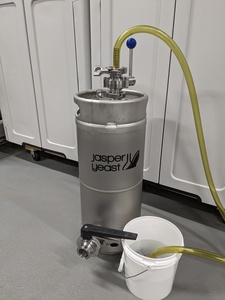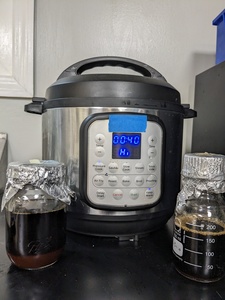Troubleshooting 101- Forced Fermentations

This is a first in a series of articles that will help new brewers isolate and troubleshoot potential issues, resulting in a stalled fermentation. These notes can provide a refresher course for more seasoned brewers as well.
Your beer has stalled prior to reaching the expected terminal gravity! While this can be stressful, it's not the end of the world, and your batch very likely can be resurrected. It's far worse to detect an off or infected flavor in beer, rather than underattenuation.
First, as a brewer and lab operator, I can share that yeast is not designed to stop prior to reaching your desired terminal gravity. Yeast will do everything possible to thrive in the environment that you provide. This can be a hard pill to take, but in many instances, you the brewer have created a scenario where proper fermentation and cell growth is a challenge. Hey, fermentation is not ideal compared to respiration.
In this example, you brewed an 18P OG IPA. You pitched a 6th generation ale strain with an expected attenuation of 70-75% with medium flocculation. Four days into fermentation you see the batch slow to a crawl, sitting at 7P. You were hoping to reach a terminal gravity of at least 5P (72% attenuation). Temperature was set at 70F but has now dropped to 67F. What do you do first?
Is this a new batch or have you brewed it in the past? Historical data is great if it's a core recipe. We always recommend using a forced fermentation test to measure expectations with reality. Even a standard recipe can produce different end results if parameters are slightly different.
Forced fermentations are a great way to look into the future of a fermentation, not just for lagers, but for ales as well. A forced ferment will let you measure the fermentability of the wort you produced and help you time other steps in the cellar. It will also help you narrow down potential issues. If the forced fermentation reaches your expected attenuation but the larger batch does not, It's possible there's an issue with the fermentation. There are other testing methods that more accurately address yeast health, but forced ferments are still valuable on several fronts when trouble shooting a batch.
If both the forced ferment and the full sized batch underperform, you know you have an issue with your wort. You'll now need to consider the following;
1.wort composition (fermentability of sugar sources)
2. mash temperatures
3. mash duration.
We'll dive into specific fermentation issues and wort composition issues in other articles. In this section, we'll share how to setup a forced fermentation on your batch.
The best setup for forced fermentation includes the following;
1. erlenmeyer flask
2. stir bar and stir plate with heating element
3. a proportional overpitch of yeast
4. wort sample from the original batch.
The heated flask with stir bar will keep the yeast in suspension while maintaining ideal temperatures for yeast health. Set the temperature to 80-85F for best results.
Add additional yeast to the sample to rule out the risk of under pitching the batch. The stir bar will overaerate the batch and create more cell growth than in the fermenter, so it's not an equal comparison, the flask vs. the fermenter. For this reason, even the most successful fermentation might still have a slightly lower attenuation than the forced ferment. It still provides a quality point of reference. Many forced fermentations should be labelled "forced aeration"
Forced Fermentation
Another option is to pull a sample from the pitched batch and place in a warmer space without a stir bar. This is great for lagers and is a more realistic, small version of the larger batch that metabolizes sugars exclusively through fermentation. This can also provide information on a fermentation, rather than placing it on a shaker plate that will over aerate the sample. If the forced ferment is significantly higher than the batch, you should look into the following;
1. yeast health (generation pitched, viability tests)
2. dissolved aeration in wort
3. yeast flocculation
4. yeast nutrient level
5. fermentation temperature
In the example of the 18P wort that stopped at 7P, the forced fermentation with stir bar also stopped at 7P. This would show that there was an issue with the wort composition or mash. How could this happen? The mash temperature was too warm (158F) due to a poorly calibrated temperature probe. Another culprit could be not checking the mash with an iodine stain to confirm complete conversion of the starches to sugars.
First, as a brewer and lab operator, I can share that yeast is not designed to stop prior to reaching your desired terminal gravity. Yeast will do everything possible to thrive in the environment that you provide. This can be a hard pill to take, but in many instances, you the brewer have created a scenario where proper fermentation and cell growth is a challenge. Hey, fermentation is not ideal compared to respiration.
In this example, you brewed an 18P OG IPA. You pitched a 6th generation ale strain with an expected attenuation of 70-75% with medium flocculation. Four days into fermentation you see the batch slow to a crawl, sitting at 7P. You were hoping to reach a terminal gravity of at least 5P (72% attenuation). Temperature was set at 70F but has now dropped to 67F. What do you do first?
Is this a new batch or have you brewed it in the past? Historical data is great if it's a core recipe. We always recommend using a forced fermentation test to measure expectations with reality. Even a standard recipe can produce different end results if parameters are slightly different.
Forced fermentations are a great way to look into the future of a fermentation, not just for lagers, but for ales as well. A forced ferment will let you measure the fermentability of the wort you produced and help you time other steps in the cellar. It will also help you narrow down potential issues. If the forced fermentation reaches your expected attenuation but the larger batch does not, It's possible there's an issue with the fermentation. There are other testing methods that more accurately address yeast health, but forced ferments are still valuable on several fronts when trouble shooting a batch.
If both the forced ferment and the full sized batch underperform, you know you have an issue with your wort. You'll now need to consider the following;
1.wort composition (fermentability of sugar sources)
2. mash temperatures
3. mash duration.
We'll dive into specific fermentation issues and wort composition issues in other articles. In this section, we'll share how to setup a forced fermentation on your batch.
The best setup for forced fermentation includes the following;
1. erlenmeyer flask
2. stir bar and stir plate with heating element
3. a proportional overpitch of yeast
4. wort sample from the original batch.
The heated flask with stir bar will keep the yeast in suspension while maintaining ideal temperatures for yeast health. Set the temperature to 80-85F for best results.
Add additional yeast to the sample to rule out the risk of under pitching the batch. The stir bar will overaerate the batch and create more cell growth than in the fermenter, so it's not an equal comparison, the flask vs. the fermenter. For this reason, even the most successful fermentation might still have a slightly lower attenuation than the forced ferment. It still provides a quality point of reference. Many forced fermentations should be labelled "forced aeration"
Forced Fermentation
Another option is to pull a sample from the pitched batch and place in a warmer space without a stir bar. This is great for lagers and is a more realistic, small version of the larger batch that metabolizes sugars exclusively through fermentation. This can also provide information on a fermentation, rather than placing it on a shaker plate that will over aerate the sample. If the forced ferment is significantly higher than the batch, you should look into the following;
1. yeast health (generation pitched, viability tests)
2. dissolved aeration in wort
3. yeast flocculation
4. yeast nutrient level
5. fermentation temperature
In the example of the 18P wort that stopped at 7P, the forced fermentation with stir bar also stopped at 7P. This would show that there was an issue with the wort composition or mash. How could this happen? The mash temperature was too warm (158F) due to a poorly calibrated temperature probe. Another culprit could be not checking the mash with an iodine stain to confirm complete conversion of the starches to sugars.

Stay in the know
Sign up for our newsletter now and hop into the world of brewing excellence.
Related Posts

How to maintain high viability in stored yeast
2023-07-05 22:33:56 UTC
By: Travis Tedrow
Congrats! You have successfully harvested yeast into your brink. Now we will outline the best practices for feeding and storing your yeast to ensure the highest possible viability.

How to DIY your own Yeast Feeders
2023-08-08 04:17:11 UTC
By: Jasper Akerboom
We ship a small bottle of autoclaved media to feed yeast pitch for every order. Below we'll detail how you can make your own yeast feeders with wort from your kettle.
